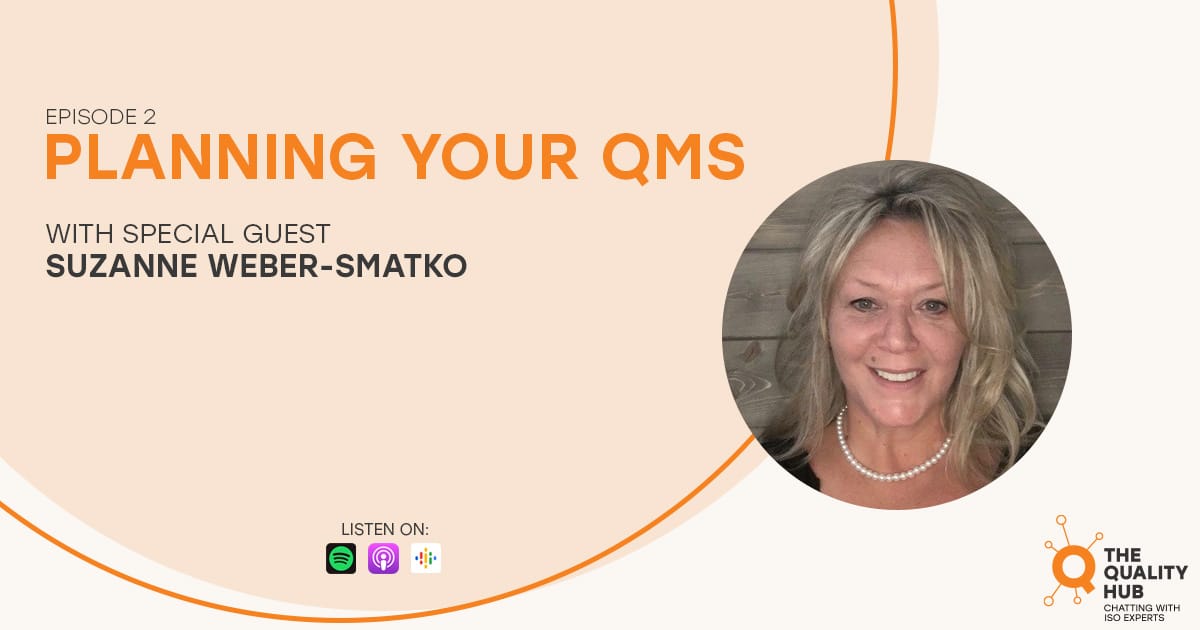Quality Policy Explained – 2023 Update
ISO 9001 is a quality management system (QMS) standard. It helps you build a QMS that pushes your business toward continual improvement. And it all comes together in your quality policy.
This short policy is essential to achieving ISO compliance. In this article, we’ll explore how to build and communicate your quality policy, and we’ll provide practical examples along the way.
With a unified direction communicated across your entire company, you can reap the full benefits of an ISO 9001 QMS.
What is a Quality Policy?
Clause 5.2 of ISO 9001 lays out the requirements for your quality policy.
As defined by ISO, a quality policy is simply a general statement of your organization’s commitment to quality. It states your commitment to customer requirements, legal requirements, and the requirements of the standard. It also contains your pledge to work toward continual improvement.

That’s simple enough. But if you dig deeper, you’ll find that this brief document is crucial to ISO 9001 success.
The quality policy aligns with your purpose and your strategic direction. It creates a framework for all future quality objectives. With the right quality policy, you can set a unified direction for your QMS to drive your entire organization.
Why Do You Need a Quality Policy?
A meaningful quality management policy statement is more than just a slogan. Your quality policy is essential to your QMS, and your QMS is essential to your business.
But what makes this policy so important?
Your quality policy flows from the knowledge and experience of top management, rooted in their high-level perception of your company’s goals, direction, and growth. It sets organization-wide quality expectations, providing a framework for all future quality objectives.
Simply put: Your quality policy sets the top-level objective of your QMS, from which all other objectives flow.
When properly crafted and communicated, your quality policy changes the culture of your business. It aligns every member of your team to a unified goal. With everyone working in the same direction, you see the real benefits of ISO 9001.
That’s why this short policy is a crucial component of your QMS.
Building Your Quality Policy
ISO 9001 requires you to write, document, communicate, and enforce your quality policy. But what does that look like in practice?
It starts with writing the actual policy.
This step can induce some anxiety for project directors, especially with the looming certification audit. Many seek out for sample policies to use as templates.

But it takes more than filling out a template. Your quality policy must reflect your purpose and context. It must stem from the specifics of your business.
To craft a quality policy that serves your company, you need to dig deep. What drives your company at its core?
Three fundamentals help answer that question:
Purpose: On a fundamental level, why does your organization exist?
Context: What internal and external issues affect your organization, and what other parties are involved?
Strategic Direction: What is the desired path of progress for your organization?
These three fundamentals form the basis of a unified direction. You’ve likely already defined them in other documents. But if not, top management should take the time to define these elements.
As you write your quality policy, you will weave together purpose, context, and strategic direction into a single statement focused on quality goals and commitments.
Remember to keep this policy specific to your business. ISO 9001 isn’t about every business doing the same things. It’s about you doing what will drive improvement in your organization.
Some Quality Policy Examples
Let’s look at some practical examples of how you might channel these fundamentals into your written statement.
Example #1 – Manufacturing
Take the example of a manufacturing company called XYZ Products:
First, they define their purpose, context, and strategic direction:
Purpose: Manufacturing precision products
Context: Small workforce, new fierce competitors entering the market
Strategic Direction: Maintain and expand market share and offer new, innovative products
From these fundamentals, XYZ Products crafts the following quality management statement
“XYZ Products is committed to manufacturing cutting-edge products of an extremely high quality to our existing and growing customer base in an accurate and timely manner. We satisfy all customer and ISO 9001:2015 requirements and continually improve our processes to enhance customer satisfaction and loyalty.”
Take another look at XYZ’s purpose, context, and direction. Can you see how they weaved those elements into their quality policy?
Example #2 – Service
Let’s look at another example. Consider a service company called Widget Services, Inc.
Purpose: Providing network management and support services
Context: Consistently changing technology, high-cost industry, large number of competitors
Strategic Direction: Provide superior services to edge out competition to maintain existing client relationships and expand into new markets.
These fundamentals translate to the following quality policy:
“Widget Services, Inc. strives to provide superior consulting services in network management and to assist clients by promptly completing tasks must meet, without compromising quality and customer service. We will assist our customers in product and solution development to achieve top quality at the lowest possible cost. We are committed to continual improvement of our services and proudly adhere to ISO requirements for excellence. We must meet or exceed our customers’ expectations and all other applicable requirements for our industry.”
Again, you can draw clear lines from Widget’s fundamentals to their quality policy. Notice that this statement is somewhat longer than our previous example. Remember: there’s no set format or template. It’s about what works for your specific organization.
Helpful Resources: Planning your QMS
Planning Your QMS Podcast
In this week’s podcast, Suzanne Weber-Smatko, Manager of Consulting Services here at Core Business Solutions, will guide us on how to start planning your QMS. Suzanne discusses the creation of a quality manual, the importance of using the PDCA cycle when beginning the process of planning, and the importance of maintaining documentation. Listen Now
Communicating Your Quality Policy
Your quality policy won’t be the driving force of your QMS if it’s just sitting in a folder somewhere.
Communication is an essential next step. You need to educate your team so that everyone in your organization can understand and apply the policy.

This is vital for certification. During your certification audit, the registrar will ask employees about your quality policy.
Employees aren’t expected to know the policy by heart, but they’re expected to convey the main themes of the policy and apply it to their work.
To accomplish this, you must educate your team. To educate your team, you need a communication plan.
Employ multiple channels. Provide visual and auditory explanations of the policy. Allow time for the policy to become part of your team’s vocabulary. Make the policy easily available to all interested parties, from employees to contractors.
Here are some suggestions:
Town Hall-Style Meetings. Gather your team and share information directly from your quality department or business leaders.
Email Communication. Use email to inform team members and key stakeholders about the new policy. Offer an in-depth explanation of its purpose and importance.
Print Materials. Use posters, stickers, or even t-shirts. Give each team member a physical copy of the quality policy to keep and read independently.
Repeating the quality policy at key points. State the quality policy during morning announcements or at the start of team meetings.
You might get some pushback, but stay diligent. Remind your team why you’re pursuing ISO certification. Explain how the quality policy impacts that success. Convey the benefits they will receive from the policy, such as clearer expectations, new opportunities, and safer, more efficient processes.
Setting Quality Objectives
With your quality policy developed and approved, you can use it to develop your quality objectives.
You can have any number of quality objectives to measure any number of processes. But remember, these objectives must help you determine the quality of your products and deliverables. Set measurable goals so you can objectively determine whether you’ve reached them.
You could set objectives for supplier lead times, productivity, and even maintenance workflows. Choose whatever objectives will help you live out your quality policy. These objectives will help guide your processes to deliver continually-improving products and services.
Rule of Thumb:
If it impacts the customer’s experience with your product or deliverable, it’s eligible to have a related quality objective.
Think back to XYZ’s quality policy. They state a commitment to address their customers in an “accurate and timely manner.”
How would this part of their quality policy inform their quality objectives?
They might create an objective for the time it takes to send quotes to customers. Again, the objective must be measurable.

Something like “Address all quote requests quickly” is too vague for a quality objective. However, something like “Address all quote requests within 24 hours of receipt” is a definite, measurable objective, and it directly relates to the quality policy.
Chances are, you have many factors that impact your output quality. Creating quality objectives for every single factor might be impossible. So don’t just think about what could be addressed, think about what should be addressed. Which processes have the biggest impact on your quality? Focus your quality objectives for those factors.
These decisions can be overwhelming. That’s one reason to seek the help of an expert consultant.
Maintaining Your Quality Policy
You’ll craft your quality policy in the beginning stages of ISO implementation. But that doesn’t mean you can close the book and call it done.
Your quality policy is a controlled document. At least once a year, evaluate it. Management meetings are the ideal time for this. Make sure the policy still fits your needs. Your business is always changing, and your quality policy should change with it.
This process provides an opportunity to explore the foundations of your business. Take the time to make it count. Consider its impact on your business. A well-crafted quality policy creates effective change that drives your company forward.
Learn more about ISO 9001 with our free PDF guide. Ready to start seeing the benefits of ISO 9001? Contact us today for a free quote.
About Scott Dawson
Since 2010, Scott Dawson, President of Core Business Solutions, has been an active voting member of the U.S. Technical Advisory Group (TAG) to ISO Technical Committee 176 (TC 176). TAG 176 members meet to discuss and develop U.S. positions for Quality Management standards, including ISO 9001:2015, which will be revised in 2026.





